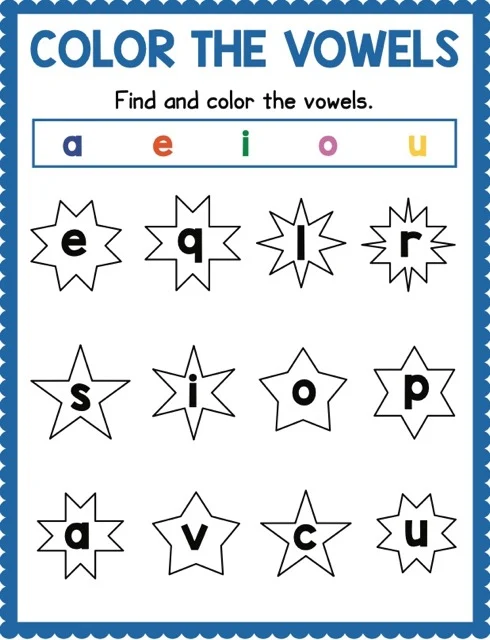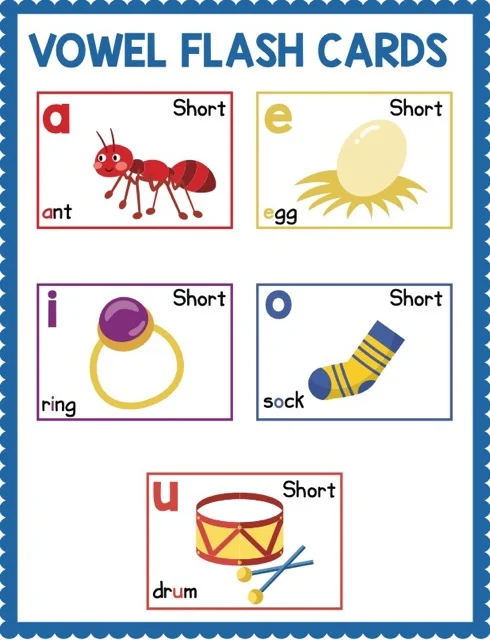Long and Short Vowel Sounds in English
This document explains the difference between long and short vowel sounds in English, emphasizing their importance for reading and spelling. It outlines key rules like the silent "e" rule and the two vowels together rule, provides examples and strategies for teaching these concepts, and highlights common challenges learners face. The importance of differentiating these sounds for reading fluency, spelling accuracy, and decoding new words is stressed. Effective teaching methods, such as using visual aids and engaging activities, are recommended to help students master this crucial literacy skill.
Long and Short Vowel Sounds in English
Briefing Document: Long and Short Vowel Sounds
This document summarizes key information from provided excerpts focusing on the differentiation and application of long and short vowel sounds in English.
Core Concepts:
●
Vowels vs. Consonants: Vowels are sounds produced with unobstructed airflow ("a," "e," "i," "o," "u"). Consonants involve partial or complete airflow blockage using the tongue, teeth, or lips.
●
Long Vowel Sound: The sound corresponds to the name of the vowel, as in "cake" for the long "a" sound.
●
Short Vowel Sound: A quicker sound not reflecting the vowel's name, as in "cat" for the short "a" sound.
Key Rules and Examples:
●
Silent E Rule: A silent "e" at the end of a word usually signals a long vowel sound in the preceding syllable, exemplified by "cake."
●
Two Vowels Together Rule: When two vowels appear consecutively, the first typically carries the long vowel sound, as in "boat."
●
Word Families: Recognizing patterns within word groups sharing a base and similar spellings aids vowel sound identification.
Importance of Long and Short Vowel Distinction:
●
Reading Fluency: Accurate vowel sound recognition enhances reading speed and accuracy.
●
Spelling Accuracy: Understanding the connection between sound and spelling choices for vowels is crucial.
●
Decoding New Words: Applying vowel sound knowledge helps decipher unfamiliar words encountered in reading.
Learning Support:
●
Rhyming Activities: Grouping words with similar vowel sounds reinforces sound-spelling connections.
●
Visual Aids: Posters with images representing words with specific vowel sounds provide visual reinforcement (e.g., apple for short "a," unicorn for long "u").
Challenges and Strategies:
●
Differentiating Sounds: Learners may struggle to distinguish subtle sound differences, requiring focused listening practice and explicit instruction.
●
Exceptions to Rules: Highlighting words that deviate from the Silent E or Two Vowels Together rules prevents over-generalization.
Pedagogical Implications:
●
Lesson Design: Engaging activities for teaching vowel sounds include word sorts, rhyming games, and picture-word matching exercises.
●
Assessment: Evaluation methods should encompass reading, spelling, and the application of vowel sound rules in diverse contexts.
Quotes:
●
"A long vowel sound says the name of the letter, while a short vowel sound is a quick sound that does not sound like the name of the letter."
●
"Understanding long and short vowel sounds helps with spelling because it allows you to choose the correct vowel letter(s) to represent the sound you want to make."
Conclusion:
Mastering long and short vowel sounds is foundational to literacy development. This involves not just recognizing the sounds but also understanding the rules governing their use and applying this knowledge to decode and spell words effectively. Providing explicit instruction, engaging activities, and visual aids are crucial for supporting learners in achieving vowel sound proficiency.
Long and Short Vowel Sounds
Vowel Sounds FAQ
1. What are vowels?
Vowels are sounds made when air flows freely out of your mouth. They are the opposite of consonants, where your tongue, teeth, or lips partially block the airflow. In written English, the letters a, e, i, o, and u represent vowels.
2. What is a long vowel sound?
A long vowel sound says the name of the letter. For example, the "a" in "cake" has a long vowel sound because it sounds like you are saying the name of the letter "a."
3. What is a short vowel sound?
A short vowel sound is a quick sound that doesn't sound like the name of the letter. For example, the "a" in "cat" has a short vowel sound.
4. Can you give examples of words with long vowel sounds?
●
Long a: cake, rain, day
●
Long e: see, tree, me
●
Long i: bike, kite, time
●
Long o: bone, home, so
●
Long u: cute, flute, mule
5. Can you give examples of words with short vowel sounds?
●
Short a: cat, hat, map
●
Short e: bed, pen, red
●
Short i: pig, win, six
●
Short o: hot, dog, top
●
Short u: cup, sun, bug
6. Why is it important to learn about long and short vowels?
Understanding long and short vowels helps you:
●
Read words correctly.
●
Spell words correctly.
●
Decode new words you encounter.
7. Are there any tricks to remember long and short vowel sounds?
Yes! There are some helpful rules, like:
●
Silent E Rule: When a word ends in a silent "e," the vowel before it usually has a long sound (like in "cake").
●
Two Vowels Together: When two vowels are next to each other, the first vowel usually has a long sound (like in "boat").
8. Where can I find more practice with long and short vowels?
You can find lots of practice online and in workbooks. You can also play word games, read books, and have fun with rhyming activities!
Long and Short Vowel Sounds
Long and Short Vowel Sounds Study Guide
Quiz
Instructions: Answer the following questions in 2-3 sentences each.
1.
What is the key difference between a vowel sound and a consonant sound?
2.
Explain the difference between a long vowel sound and a short vowel sound.
3.
Provide three examples of words containing a long "i" sound.
4.
Provide three examples of words containing a short "o" sound.
5.
State the Silent E Rule and provide an example.
6.
State the Two Vowels Together Rule and provide an example.
7.
How does understanding long and short vowel sounds help with spelling?
8.
How can rhyming activities help you learn about long and short vowel sounds?
9.
Using the provided posters as a reference, name one image associated with the short "a" sound and one image associated with the long "u" sound.
10.
Beyond rules like the Silent E Rule, what is another strategy you can use to remember whether a vowel sound is long or short?
Quiz Answer Key
1.
Vowel sounds are produced when air flows freely out of the mouth, while consonant sounds involve the tongue, teeth, or lips partially blocking the airflow.
2.
A long vowel sound says the name of the letter, while a short vowel sound is a quick sound that does not sound like the name of the letter.
3.
Examples of words with a long "i" sound: time, shine, bright.
4.
Examples of words with a short "o" sound: dog, hop, clock.
5.
The Silent E Rule states that when a word ends in a silent "e," the vowel before it usually has a long sound. Example: "cake".
6.
The Two Vowels Together Rule states that when two vowels are next to each other, the first vowel usually has a long sound. Example: "boat".
7.
Understanding long and short vowel sounds helps with spelling because it allows you to choose the correct vowel letter(s) to represent the sound you want to make.
8.
Rhyming activities help you learn about long and short vowel sounds by exposing you to groups of words that share similar vowel sounds, which reinforces the connection between sounds and spellings.
9.
Short "a": apple, hat (answers may vary based on poster selection). Long "u": flute, unicorn (answers may vary based on poster selection).
10.
Another strategy to remember whether a vowel sound is long or short is to memorize common spelling patterns and word families.
Essay Questions
1.
Explain how understanding long and short vowel sounds contributes to reading fluency and comprehension.
2.
Discuss the challenges that learners might encounter when trying to differentiate between long and short vowel sounds, and suggest strategies to overcome these challenges.
3.
Compare and contrast the Silent E Rule and the Two Vowels Together Rule, providing examples to illustrate their application and any exceptions to these rules.
4.
Analyze the role of visual aids, such as the posters provided, in supporting the learning of long and short vowel sounds. What are the benefits and limitations of using such visual aids?
5.
Design a lesson plan for teaching long and short vowel sounds to a group of early elementary students. Include engaging activities, examples, and assessments.
Glossary of Key Terms
●
Vowel: A speech sound produced by the relatively free passage of breath through the mouth, forming the nucleus of a syllable.
●
Consonant: A speech sound produced by partially or completely obstructing the flow of air through the mouth (using the tongue, teeth, or lips).
●
Long Vowel Sound: A vowel sound that says the name of the letter.
●
Short Vowel Sound: A quick vowel sound that does not sound like the name of the letter.
●
Silent E Rule: When a word ends in a silent "e," the vowel before it usually has a long sound.
●
Two Vowels Together Rule: When two vowels are next to each other, the first vowel usually has a long sound.
●
Decoding: The process of translating written words into spoken sounds.
●
Rhyme: Words that have the same ending sound.
●
Word Family: A group of words that share a common base or root word and have similar spelling patterns and meanings.






















